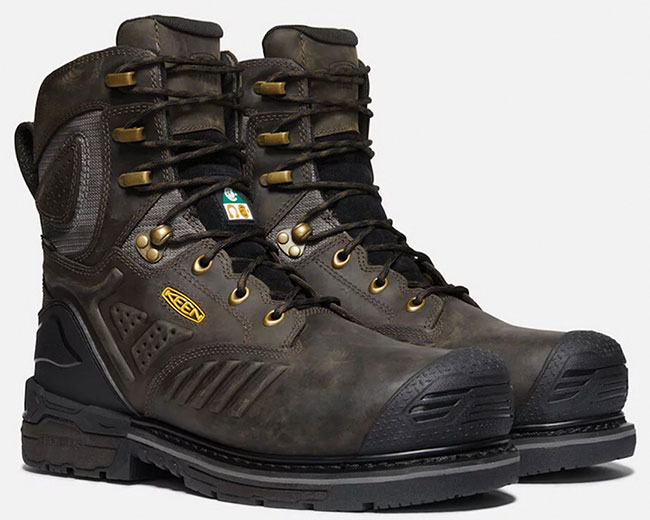
Features
Landscaping
Snow & Ice
Health & Safety: Think about your feet working in winter
December 12, 2019 By the CCOHS
 Boots should not only include the necessary safety features, they should be warm and dry in winter. Keen footwear photo
Boots should not only include the necessary safety features, they should be warm and dry in winter. Keen footwear photo Every day, and with every step, we expose our feet to potential physical injury. Foot problems can occur in almost any workplace and under a wide variety of working conditions. In Canada, the winter introduces unique hazards. Canadian Standards Association (CSA)-approved safety footwear provides protection from workplace hazards such as crushes, burns and punctures, but during the colder months there are cold weather afflictions that can also have painful and sometimes serious consequences. Learn more about the harm that working in cold weather can cause your feet.
Exposure to cold (not just cold feet)
During the winter, working at outdoor jobs can mean working in freezing temperatures, or in low temperature wet conditions, which can put feet at risk of frostbite, chilblains, and trench foot.
Frostbite
Frostbite is caused from freezing of the skin and underlying tissues. First your skin becomes very cold and red, then numb, hard and pale. Frostbite is most common on the fingers, toes, nose, ears, cheeks and chin.
Symptoms of frostbite include reduced blood flow to hands and feet, numbness or a loss of feeling, tingling or stinging, aching, and bluish or pale, waxy skin. Frostbite can permanently damage body tissues, and severe cases can lead to amputation.
Chilblains
Repeated exposure to cold, but not freezing, air can result in chilblains, the painful inflammation of small blood vessels in your skin. Chilblains can cause itching, red patches, swelling, and blistering on your feet and hands.
Chilblains usually clear up within one to three weeks, especially if the weather gets warmer or exposure stops. Chilblains don’t usually result in permanent injury. But the condition can lead to infection, which may cause severe damage if left untreated.
Trench foot
Trench foot is an injury of the feet resulting from prolonged exposure to wet and cold conditions. Trench foot can occur at temperatures as high as 15 degrees Celsius if the feet are constantly wet. Injury occurs because wet feet lose heat 25 times faster than dry feet. Therefore, to prevent heat loss, the body constricts blood vessels to shut down circulation in the feet. Skin tissue begins to die because of lack of oxygen and nutrients, and due to the buildup of toxins.
Symptoms of trench foot include reddening of the skin, numbness, leg cramps, swelling, tingling pain, blisters or ulcers, bleeding under the skin, and gangrene (the foot may turn dark purple, blue, or grey).
Wearing appropriate footwear and socks is an important step in protecting the feet from cold.
Appropriate footwear
“Normal” protective footwear is not designed for cold weather while “insulated” footwear may give little temperature protection in the sole, where there is no insulation. Loss of heat through steel toe caps (commonly blamed for increased heat loss) is insignificant.
Insulating the legs by wearing thermal undergarments, wearing insulating overshoes over work footwear, and wearing insulating muffs around the ankles and over the top of the footwear can help provide foot protection against cold weather.
Felt-lined, rubber bottomed, leather-topped boots with removable felt insoles are best suited for heavy work in cold since leather is porous, allowing the boots to breathe and perspiration to evaporate. Leather boots can be waterproofed with products that do not block the pores in the leather.
For work that involves standing in water or slush, waterproof boots must be worn. However, while these boots protect the feet from getting wet from cold water, they also prevent perspiration from escaping. The insulating materials and socks will become wet more quickly than when wearing leather boots, and increase the risk for frostbite.
Socks
Always wear the right thickness of socks for your boots. If they are too thick, the boots will be tight, and the socks will lose much of their insulating properties when they are compressed inside the boot. If socks are too thin, boots will fit loosely and may lead to blisters.
The Canadian Centre for Occupational Health and Safety (CCOHS) promotes the total well being of workers in Canada by providing information, training, education, systems and solutions that support health and safety programs and injury and illness prevention.
www.ccohs.ca
Print this page